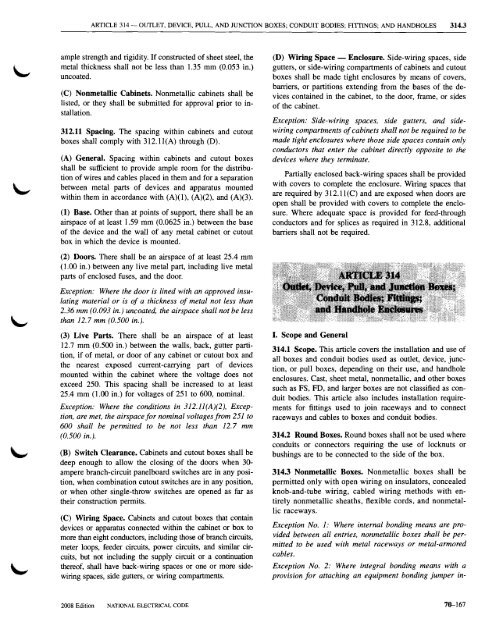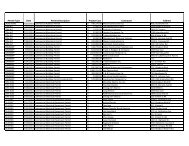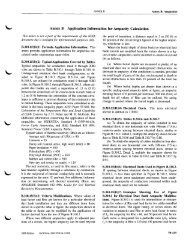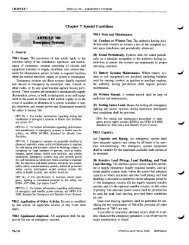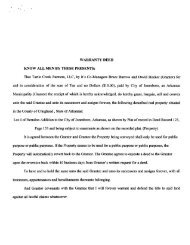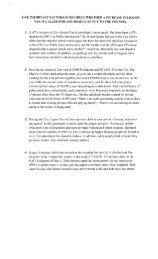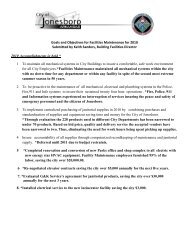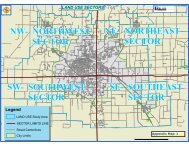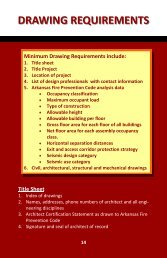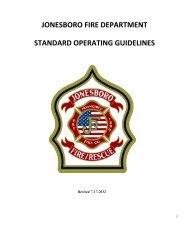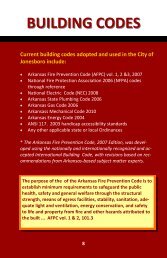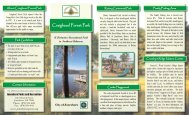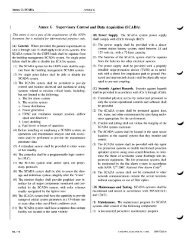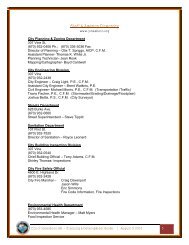Chapter 3 Wiring Methods and Materials
Chapter 3 Wiring Methods and Materials
Chapter 3 Wiring Methods and Materials
Create successful ePaper yourself
Turn your PDF publications into a flip-book with our unique Google optimized e-Paper software.
ARTICLE 314 - OUTLET, DEVICE, PULL, AND JUNCTION BOXES; CONDUIT BODIES; FITTINGS; AND HANDHOLES 314.3<br />
ample strength <strong>and</strong> rigidity. If constructed of sheet steel, the<br />
metal thickness shall not be less than 1.35 mm (0.053 in.)<br />
uncoated.<br />
(C) NonmetalJic Cabinets. Nonmetallic cabinets shall be<br />
listed, or they shall be submitted for approval prior to installation.<br />
312.11 Spacing. The spacing within cabinets <strong>and</strong> cutout<br />
boxes shall comply with 312.Il(A) through (D).<br />
(A) General. Spacing within cabinets <strong>and</strong> cutout boxes<br />
shall be sufficient to provide ample room for the distribution<br />
of wires <strong>and</strong> cables placed in them <strong>and</strong> for a separation<br />
between metal parts of devices <strong>and</strong> apparatus mounted<br />
within them in accordance with (A)(l), (A)(2), <strong>and</strong> (A)(3).<br />
(1) Base. Other than at points of support, there shall be an<br />
airspace of at least 1.59 mm (0.0625 in.) between the base<br />
of the device <strong>and</strong> the wall of any metal cabinet or cutout<br />
box in which the device is mounted.<br />
(D) <strong>Wiring</strong> Space - Enclosure. Side-wiring spaces, side<br />
gutters, or side-wiring compartments of cabinets <strong>and</strong> cutout<br />
boxes shall be made tight enclosures by means of covers,<br />
barriers, or partitions extending from the bases of the devices<br />
contained in the cabinet, to the door, frame, or sides<br />
of the cabinet.<br />
Exception: Side-wiring spaces, side gutters, <strong>and</strong> sidewiring<br />
compartments of cabinets shall not be required to be<br />
made tight enclosures where those side spaces contain only<br />
conductors that enter the cabinet directly opposite to the<br />
devices where they terminate.<br />
Partially enclosed back-wiring spaces shall be provided<br />
with covers to complete the enclosure. <strong>Wiring</strong> spaces that<br />
are required by 312.1l(C) <strong>and</strong> are exposed when doors are<br />
open shall be provided with covers to complete the enclosure.<br />
Where adequate space is provided for feed-through<br />
conductors <strong>and</strong> for splices as required in 312.8, additional<br />
barriers shall not be required.<br />
(2) Doors. There shall be an airspace of at least 25.4 mm<br />
(1.00 in.) between any live metal part, including live metal<br />
parts of enclosed fuses, <strong>and</strong> the door.<br />
Exception: Where the door is lined with an approved insulating<br />
material or is of a thickness of metal not less than<br />
2.36 mm (0.093 in.) uncoated, the airspace shall not be less<br />
than 12.7 mm (0.500 in.).<br />
(3) Live Parts. There shall be an airspace of at least<br />
12.7 mm (0.500 in.) between the walls, back, gutter partition,<br />
if of metal, or door of any cabinet or cutout box <strong>and</strong><br />
the nearest exposed current-carrying part of devices<br />
mounted within the cabinet where the voltage does not<br />
exceed 250. This spacing shall be increased to at least<br />
25.4 mm (1.00 in.) for voltages of 251 to 600, nominal.<br />
Exception: Where the conditions in 312. 11(A)(2), Exception,<br />
are met, the airspace for nominal voltages from 251 to<br />
600 shall be permitted to be not less than 12.7 mm<br />
(0.500 in.).<br />
(B) Switch Clearance. Cabinets <strong>and</strong> cutout boxes shall be<br />
deep enough to allow the closing of the doors when 30<br />
ampere branch-circuit panelboard switches are in any position,<br />
when combination cutout switches are in any position,<br />
or when other single-throw switches are opened as far as<br />
their construction permits.<br />
(C) <strong>Wiring</strong> Space. Cabinets <strong>and</strong> cutout boxes that contain<br />
devices or apparatus connected within the cabinet or box to<br />
more than eight conductors, including those of branch circuits,<br />
meter loops, feeder circuits, power circuits, <strong>and</strong> similar circuits,<br />
but not including the supply circuit or a continuation<br />
thereof, shall have back-wiring spaces or one or more sidewiring<br />
spaces, side gutters, or wiring compartments.<br />
I. Scope <strong>and</strong> General<br />
314.1 Scope. This article covers the installation <strong>and</strong> use of<br />
all boxes <strong>and</strong> conduit bodies used as outlet, device, junction,<br />
or pull boxes, depending on their use, <strong>and</strong> h<strong>and</strong>hole<br />
enclosures. Cast, sheet metal, nonmetallic, <strong>and</strong> other boxes<br />
such as FS, FD, <strong>and</strong> larger boxes are not classified as conduit<br />
bodies. This article also includes installation requirements<br />
for fittings used to join raceways <strong>and</strong> to connect<br />
raceways <strong>and</strong> cables to boxes <strong>and</strong> conduit bodies.<br />
314.2 Round Boxes. Round boxes shall not be used where<br />
conduits or connectors requiring the use of locknuts or<br />
bushings are to be connected to the side of the box.<br />
314.3 NonmetalJic Boxes. Nonmetallic boxes shall be<br />
permitted only with open wiring on insulators, concealed<br />
knob-<strong>and</strong>-tube wiring, cabled wiring methods with entirely<br />
nonmetallic sheaths, flexible cords, <strong>and</strong> nonmetallic<br />
raceways.<br />
Exception No.1: Where internal bonding means are provided<br />
between all entries, nonmetallic boxes shall be permitted<br />
to be used with metal raceways or metal-armored<br />
cables.<br />
Exception No.2: Where integral bonding means with a<br />
provision for attaching an equipment bonding jumper in<br />
2008 Edition NATIONAL ELECTRICAL CODE<br />
70-167


